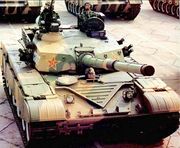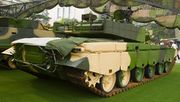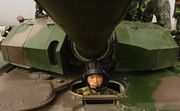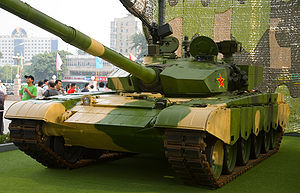Type 99
|
||||||||||||||||||||||||||||||||||||||||
|
||||||||||||||||||||||||||||||||||||||||
The Type 99, also known as ZTZ-99 and WZ-123, developed from the Type 98G (in turn, a development of the Type 98), is a third generation main battle tank (MBT) fielded by the Chinese People's Liberation Army. It is made to compete with other modern tanks. Although not expected to be acquired in large numbers due to its high cost compared to the more economical Type 96, it is currently the most advanced MBT fielded by China. The ZTZ99 MBT is considered one of the 12 best tanks in the world,[4] and is a successor to the Type 98 G tank manufactured for the People's Liberation Army (PLA).
Contents |
Development
At the end of 1970, the Type 122 Experimental Medium Tank project was aborted after three years of development. In February 1977, work on a second-generation PRC tank was begun, and in April 1978, the development goals for the new project were set. The Soviet T-72 was the tank's primary projected combat target. In March of 1979, Chinese government Institutes 617 and 201 developed the new Type 1224 experimental chassis, which had been installed with the MB8v331TC41 model tank imported from Germany. Later, another two models were developed, the Type 1226, with the "8V165", a 763kW, 1,000 horsepower diesel engine by Factory 636, and the Type 1226F2, with the "12V150" 763kW, 1,000 horsepower engine by Factory 616. All three prototypes were armed with 120mm smoothbore cannons. Ammunition was placed behind the turret, similar to the design philosophy of the German Leopard 2 A1.
After the designation of the Type 80 as the PRC's second-generation tank in 1981, groups emerged within the Chinese military who argued that a third, more advanced tank generation was still needed. Out of these, two main camps emerged. One group argued for a design based on the Soviet T-72, with 3 crewmembers and a 125mm autoloader cannon. The other favored an Israeli Merkava-styled design with a power pack closer to the front of the tank, a 120mm semi-automatic-loading cannon, and a high output diesel or gas turbine engine. The project was delayed for some years because of the division. Finally, in July 1984, the Army settled on the T-72-based design. In the summer of 1986, the plan was submitted to China's State Council and Central Military Commission. It was approved in the same year, and incorporated into the Major Weapons Development program of China's Seventh Five-Year Plan.
In the Spring of 1989, Norinco signed a contract with the Chinese government to manufacture the Type 99. At the beginning of the following year, it's Factory 617 produced the first Type 99 prototype. In 1993, the front armor plating on the Type 99 was increased from 600mm to 700mm to meet government specifications. In August 1994, two prototypes produced by Norinco underwent climate durability tests in southern China. During the tests, the prototypes were driven 3800 kilometers and 200 rounds were fired. In September of 1994, reliability and fording tests were carried out in the Tuoli and Huiahuling regions outside of Beijing. Additionally, from 1995 to 1996, three prototypes underwent arctic climate tests in Tahe County, Heilongjiang.
On March 12, 1996, the Type 99 project formally moved into the final stage of development. In May 1996, Norinco's Factory 617 started the assembly of a finalized prototype. At the end of December, 1996, two finalized prototypes were again transported to Tahe for further arctic testing. Within the two month testing period, the prototypes were driven a total of 6,900 kilometers and 20 government testing programs were completed. At the end of 1997, four finalized prototypes underwent additional testing, travelling a collective 20,000 kilometers and test firing 760 rounds. Finally, at the end of 1999, following over five years of extensive government testing, the design of the T-98, as it was then known, was fully completed. Its firepower, control systems, armor and electronics were deemed by the Army to have met or exceeded the project's original goals. Small-scale production of the T-98 was begun in time for the tank to be featured in the PRC's National Day parade in 1999.
Following the completion of the T-98, research into improved versions of the tank continued within the Chinese government. These programs produced the Type 98G, a refined iteration of the T-98 with a better reliability record. At the end of 2001, the first batch of 40 Type 98G tanks entered service with the regular Army. The T-98G eventually gave rise to what is now known as the Type 99, which was officially revealed by the government in 2001. The final version of the Type 99 included a 1,500 horsepower engine, as opposed to its immediate predecessor's 1,200 horsepower powertrain. Also added were a Leopard 2A5-style sloped-arrow armor plate on the front of the turret, and additional composite armor layers on the sides.
Norinco's official designation for the Type 99 is "ZTZ-99". The tank is also known as the "WZ-123 MBT". The unit price for one Type 99 is estimated to be greater than 16 million yuan, (2 million US, 1.6 million EUR). In part due to its high cost, the tank is not expected to be deployed in large numbers, unlike earlier Chinese designs such as the Type 59. Because of the limited nature of its production, the Type 99 is currently only operated by the PLA's most elite divisions, while the Type 96 tank has become the force's new backbone.
Type 98
The Chinese government made a decision to modernize their tank force by incorporating advanced features into their next-generation MBT, as their older tanks were becoming ineffective. The resulting tank had a hull (chassis) similar to the T-72 or T-80 while having a welded turret like most Western tanks. The aim was to create a tank which could defeat the Soviet T-80 and approach the capabilities of the German Leopard 2.
Type 98

This prototype is unique among current Chinese designs. Instead of an autoloader, it has a fourth crew member to manually load the western-style single unit ammunition rounds. Traditional Soviet-style autoloaders were designed to separately load the propellant and warhead components. The transmission is manual instead of automatic like those on the newer Type 90. The tank can also fire DU (Depleted Uranium) rounds.
Type 98G
The most obvious feature is that a modified autoloader was installed so that the crew was reduced to three from the original four. The power plant is a domestic 150HB 1,200-hp diesel engine. It is able to fire depleted uranium rounds.
Type 99
The basic variant of the Type 99 series. The latest variant that is in full service is the Type 99A2 with a 1,500-hp water cooled diesel engine and getting re-designed at some parts. The newest in trial is the Type 99KM.
The Type 99A2 has increased armor on the turret. The self-defense laser module has been replaced by an active defensive module. The ZTZ-99A2 also installed ERA on the front and side turret. The tank hull will follow the MBT 2000 configuration instead of the previously used hull.
Type 99G
CNGC has been deploying a further modified version of the ZTZ99, possibly known as ZTZ99G. A photo released by the Chinese official Xinhua News Agency in February 2008 revealed an improved variant of the ZTZ99 that features newly designed observation and active protection system (APS). The commander viewer of the new tank appears to be slightly larger than that of the basic variant ZTZ99, suggesting a possible independent commander thermal imaging viewer.
Type 99A
Successor to the Type 99G and predecessor to the Type 99A1.
Type 99A1
The Type 99A1 is the latest version in service of the PLA while the more advanced variant the Type 99A2 is still in various trials and is not expected to enter service before the end of 2009. While the earlier Type 99 that entered service several years ago had additional armor packages on the original Type 98 turret and the chassis, the Type 99A1 has its turret top reshaped, having the hump on the turret's top removed by thickening it. This might be the result for changing the height of the turret itself to improve more protection or more space for the tank commander and gunner. Other distinct details are the armor packages on the front and at its sides, the ERA panels have been extended. The Type 99A1 might also have received further upgrades in terms of targeting computers etc.
Type 99A2
The much-improved Type 99 variant, with many major upgrades and improvements. Improvements are so significant that the A2 can almost be considered as a new tank. Some of the improvement and upgrades include a reaction improved aiming system, a digital battlefield information terminal, a newly designed arrow-shaped armor, a larger turret, an expanded tail chamber, an Active Protection System mounted on the turret with millimeter-wave radar, a new commander's periscope and an Integrated Propulsion System.[5]
Type 99KM
The newest and much-improved variant, with newer modular active protection system, JD-4 active laser defense system, more powerful 2100-hp engine, and more. It is also equipped with a 155 mm gun capable of firing next-generation missiles and kinetic rounds.[6]
Design

The development of the new tank was initiated in the early 1990s during the Gulf War. Western tanks had destroyed numerous Iraqi Soviet-made T-72s, which were superior to the most advanced tank in the PLA arsenal at the time: the Type 90 tank.[7] The PLA realised that their tanks were no match for the Western MBT designs such as the Challenger 2 and M1A1, and initiated a project to develop a new, modern main battle tank which eventually resulted in the Type 99. The design was heavily influenced by the Soviet T-80 and the German Leopard 2. Features include sloped turret armor for increased protection, among others. The driver's compartment is in the front while the fighting compartment lies directly behind it and the engine is installed in the rear.
To accommodate more equipment and ammunition, the Type 98's turret is slightly larger than that of the Type 90, resulting in a gap between the turret and hull in the front. This could be a major disadvantage in battle as it acts as a shot trap and exposes the turret ring, increasing the likelihood of hits from the front jamming the turret.So NORINCO provided the armor upgrades to the Type 99 which minimizes the gap to avoid a shot trap.
This effect, however, is not to be confused with the World War II shot-trap effect, for modern long-rod kinetic energy penetrators (APFSDS) behave in a different manner to traditional solid shot armour-piercing rounds. The Leopard 2A5 and 2A6 also feature this wedge on the turret front, which Leopard engineers deliberately designed to subject an incoming APFSDS round to yaw forces. This places the penetrator under enormous stress, which may shear it, thus preventing its penetration of the turret. The projectile still imparts its kinetic energy to the turret, but not in a fashion that will penetrate the armour.
The tank is equipped with an active laser defense system. The laser warning receiver can determine the location of an attacking enemy tank, while the high-powered laser dazzler can temporarily blind the enemy's optics. It can also be used as a secure communications device.
Counter Measures and Communications
The type-VHF-2000 tank communication system on Type 98 (and mostly the Type 99 too) has electronic countermeasures, electro-magnetic compatibility and multiple workstation capability. Mounted behind the commander's hatch is a laser communication and IFF system. It is a compact and multifunctional system used for IFF, sending digital command signal, voiced communication and laser detection. its receiver could function as a laser warning system on the wavelength of 0.9–1.06 µm. it has a working range of >3,600m. up and down angle of +45 degree to -10 degree (same as the commander's sight), 360 degree at horizontal level, target detection time is <0.6sec, 60 encrypted IFF code is stored in the system.
Further back on top of the turret is the type-9602 GPS navigation and position signal receiving antenna, its a two channel C/A code receiver and provide 3D military grade coordinates under all weather condition, data on tank's moving direction and speed along with those of the target can be established to provide suitable navigation route. type-9602 has a relatively low precision of 100m that fell short of some tactical requirement, once the Type 98G is equipped with the successfully developed GLONSS/GPS navigation and positioning system, the precision can be increased to 20 meters.
On the back of the gunner's hatch is an active laser suppression system, which is designed to directly attack the various guidance systems on the opponent's weapon system. it can be operated by either the commander or the gunner, the laser ray could interfere or permanently damage IR sensor's components (laser ranger; night-vision equipment; TV camera head; telescopic sight; etc.) and has obvious effect against naked eyes. The system consists of a micro-computer control box; target tracking sub-system; laser suppressor and thermal image jammer. The system can be rotated 360 degrees, +90 degree to -12 degree, horizontal tracking speed 45 degree/sec, vertical tracking speed 40 degree/sec, laser energy output is 1.000 MHz, laser pulse's working repetition rate is 10ps, maximum working range is 4,000m, continues working time is 30min, laser beamer has a lifespan of 1.2 million. In addition, the Type 98/99's driver is equipped with anti-laser glass for protection from similar system fielded on the opponent's platform.[8]
Armament

The ZTZ99's main armament includes a dual-axis fully-stabilised 125 mm/50-calibre ZPT98 smoothbore gun with a carousel-style autoloader, a thermal sleeve, and a fume extractor. It is a further development of the 120 mm Chinese Design while many foreign observers thought it would be just a Chinese version of the Soviet 2A46M-1 type 125 mm gun. The Chinese gun with 120 mm turned out to be slightly better than 125 mm in some aspect, but 125 mm was chosen due to the selection of T-72-type autoloader. The 120 mm gun end up on type-89 SPATG with a semi-autoloader. The 125 mm tank gun was successfully developed as early as 1985. After continued improvement, the ZPT98 tank gun with 125 mm achieved higher bore pressure than the 120 mm.
The gun can be fired by either electronics or manual control. The gun barrel can be replaced within one hour. Loading is mechanical with 41 rounds carried inside the turret and vehicle hull while 22 rounds are stored within the autoloader. The gun can fire about 8 rounds per minute using autoloader and 1~2 rounds per minute with manual loading. Ammunition includes armour-piercing fin stabilized discarding sabot (APFSDS), high explosive anti-tank (HEAT), and high explosive fragmentation (HE-FRAG) projectiles. China has also reportedly manufactured Soviet AT-11 laser-guided anti-tank missiles (ATGM) to be fired from the 125 mm gun for enemy tank with Explosive Reactive Armour, with an effective range of 4 km. In addition, the Chinese have developed depleted uranium (DU) rounds for their tanks and these may be available for the Type 99. The primary kinetic energy armour-piercing ammunition for the 125 mm tank gun is the APFSDS round with a 30:1 length/calibre heavy tungsten alloy penetrator and the round has a muzzle velocity of 1,780m/s and is capable of penetrating 850 mm steel armour at a distance of 2,000m. A depleted uranium (DU) APFSDS round which can penetrate 960 mm steel armour at a distance of 2,000m and the accuracy range would be approx 5 km on non moving target with APFSDS depleted uranium.
From Type 98 to all Type 99 variants, they are all armed with a ZPT98 125 mm smoothbore gun with a length/calibre ratio of 51:1. the barrel is made of high-intensity PCrN13NoV, muzzle velocity is comparable to that of Soviet 2A46M-1 type 125 mm gun. hydraulic self-strengthening technology has resulted in a much stiffer barrel, the length is 6,412 mm, it has a lifetime of 700 armor-pieceing rounds. the thermal sleeve is of a double aluminium plate structure with air gap, it consist of 5 non-interchangeable parts, its effective rate is 70%. A severely damaged ZPT98 can have its parts repaired and/or replaced on the battlefield within 1 hr.
Armor
Currently, the actual armor composition of the Type-99/ZTZ-99 remains unknown. There are public photos of experimental Chinese composite armors, specifically Al2O3 under test. The armor didn't sustain any significant damage after being shot by a T-72C 125 mm armament seven times or a 105 mm armament nine times in a range of 1,800 meters, while rounds that are used in the test are unknown. The tank's front armor protection is claimed to be equivalent to 1,000~1,200 mm of steel armor, possibly against shaped charge warheads. Also, there are significant differences between the armor packages displayed on the current Type 99s and earlier 99 models seen in 1999.
Another theory that has been suggested is that the armor additions are not ERA (Explosive Reactive Armour), but composite layers in block form. The reason is that the blocks are too large to be effectively used as ERA, since one detonation leads to a large unprotected area. Further support is given in the fact that Eastern Bloc armies had two armor packages after the introduction of ERA. Live ERA blocks for wartime and composite blocks for peacetime, as maintaining ERA blocks during operational conditions is both expensive and hazardous as well as leading to an increase in weight.
Fire Control and observation

Fire accuracy is attained by the laser rangefinder, wind sensor, ballistic computer, and thermal barrel sleeve, while essential muzzle reference system is invisible in released photographs. Dual axis stabilization ensures effective firing on the move. The commander has six periscopes and a stabilized panoramic sight. Both the commander and gunner have roof-mounted stabilized sights fitted with day/thermal channels, a laser rangefinder and an auto tracker facility. The commander has a display showing the gunner's thermal sight, enabling the commander to fire the main gun. The Thermal Imaging System (TIS) with cooled detector using processing in the element (SPRITE) technology has narrow field of view magnification of ×11.4 and ×5 in wide field of view.
The Type 99 is also fitted with a computerized onboard information processing system, which can collect information from vehicle navigation (Inertia/GPS), observation systems and sensors, process it in the computer and display it on the commander's display, giving the ability of real-time command and beyond-vision-range target engaging.
Propulsion
The Type 99 is powered by a liquid cooled, turbocharged 1,500 hp diesel derived from the German MB871ka501 diesel technology. At its current battle weight of 54 tons, this gives a power-to-weight ratio of about 27.78 hp/ton. The maximum speed on road is 80 km/h and 65 km/h cross country. Acceleration from 0 to 32 km/h only takes 12 seconds. The transmission provides seven forward and one reverse gears.[9]
Operators
 People's Republic of China: {~500 all Type 99 models}
People's Republic of China: {~500 all Type 99 models}
See also
- Type 59/62
- Type 69/79
- Type 80/85/88
- Type 90/96
- MBT 2000/Al-Khalid
- Type 98/99
- T-72
- M-84
- M-95
- PT-91
- M-2001
- T-80
- T-84
- T-90
- T-95
Notes
- ↑ English pamphlet available at "Our troops towards the Sun" exhibition
- ↑ Zippo (2006-10-10). "Type 99 MBT equipped with a 140mm gun". Chosun. http://bemil.chosun.com/brd/view.html?tb=BEMIL081&pn=1&num=32817. Retrieved 2008-02-14.
- ↑ Lung (2005-04-21). "这辆98式在测试140毫米口径火炮". Wforum. http://www.wforum.com/specials/articles/02/16004.html. Retrieved 2008-02-14.
- ↑ "ZTZ99 Chinese Main Battle Tank". Army Technology. 1999-10-01. http://www.army-technology.com/projects/type99chinese-main/. Retrieved 2010-02-07.
- ↑ "China trials enhanced Type 99 MBT - Jane's Defence News". Janes.com. 2007-08-24. http://www.janes.com/news/defence/jdw/jdw070824_1_n.shtml. Retrieved 2010-02-07.
- ↑ "ZTZ99 Type 99 WZ123 main battle tank technical data sheet". Armyrecognition.com. 2009-07-14. http://www.armyrecognition.com/china_chinese_heavy_armoured_vehicle_tank_uk/ztz99_type_99_wz123_main_battle_tank_technical_data_sheet_information_description_intelligence_uk.html. Retrieved 2010-02-20.
- ↑ ZTZ99 (Type 99) Main Battle Tank - SinoDefence.com
- ↑ (in Chinese) 中国新型坦克装备车际激光通信 协同能力获跃升. 凤凰网. http://news.ifeng.com/mil/2/200902/0202_340_989970.shtml. Retrieved 2009-02-02.
- ↑ type 99 system
External links
- Type 99 at Army-technology.com
- Type 99 at Sinodefence.com
- The Chinese Type 99 Main Battle Tank: A New Beast from the East - China-Defense.com
- The New Chinese Type 99 MBT: A Second Look Reveals More Details - China-Defense.com
- Type 99 at Globalsecurity.org
- Type 98 at Armor ID Page
- Type 98 at rusi.org
